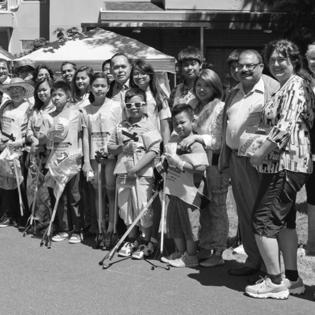Song Mapping
The song "This Land Is Your Land" describes many places in the United States in order to call out our wonderful shared places. Young people understand that a country is made up of people living in the same place and working together to keep the place wonderful for everyone. Nonprofits are found all over the country to make sure all people get their needs met.
The learner will:
- define philanthropy as giving time, talent, and treasures.
- locate, on a map of the United States, five of the places listed in the chorus of This Land is Your Land.
- describe ways even young people can take action as a volunteer.
- audio of the song This Land is Your Land
- read-aloud copy of the book This Land is Your Land
- map of the USA (see handout below)
- Guthrie, Woody and Arlo Guthrie. This Land Is Your Land. Rounder Kids C8050. Rounder Records Corp., 1997. ASIN: B000003H1, CD.
- Guthrie, Woody and Kathy Jakobsen. This Land Is Your Land. Boston: Little, Brown and Company, 1998. ISBN: 0-316-39215-4.
Instructions
Anticipatory Set:
Play the audio of the song “This Land Is Your Land” and sing along. Ask children to listen as they sing for words and concepts they want to discuss.
Spend time looking over the last tri-fold page of the book This Land Is Your Land. Discuss what is happening in the different parts of the country. What are some things people are doing that help others?
Woody Guthrie named many places in his song. What are some of the places that we could place on a map?
With a large map as a model and each child writing on their own copy of the United States outline map sheets (handout below), they mark five areas mentioned in the song.
- California: Draw a sun in the southern area of the state outline.
- New York Island: Draw a symbolic picture of the Statue of Liberty.
- Redwood Forest: Draw trees in northern or central California.
- Gulf Stream Waters: Draw waves where the Gulf of Mexico is on the map.
- Desert: Draw a cactus plant near Arizona or New Mexico.
Ask: What is a community? (Group of people working together for a common cause.) Explain that the more people in the community work together, the better the community becomes. Ask for examples of people working together in a community (sports team, faith-based organization, class, school, club, family). Our country is also a community shared and loved by many.
Explain that all communities have needs in order for everyone and every place to get what they need to do well. Volunteers can help. Talk about volunteer work in the community and in the song.
Further details: Volunteers are part of the nonprofit sector. A nonprofit organization provides goods and services through its mission. Businesses provide goods and services in order to make money. The government also provides services, but it can't help everyone.
Explain that a volunteer is a philanthropist, which means they give time, talent, or treasure for the common good.
Clarify these ideas by discussing the three Ts.
- What is your time? (recess, after school, an hour)
- What is your talent? (play music, sing, rake leaves, read a story, friendship)
- What are your treasures? (money or possessions)
Ask if there is anything young people could volunteer to do that would help make our community better. (Take suggestions.)
The children draw a picture of themselves anywhere on the map doing something as a volunteer to improve our shared community.
Handouts
Philanthropy Framework
-
Strand PHIL.I Definitions of Philanthropy
-
Standard DP 01. Define Philanthropy
-
Benchmark E.1 Define philanthropy as the giving and sharing of time, talent, or treasure intended for the common good.
-
-
Standard DP 02. Roles of Government, Business, and Philanthropy
-
Benchmark E.5 Recognize that volunteering requires freedom of choice.
-
-
-
Strand PHIL.II Philanthropy and Civil Society
-
Standard PCS 03. Philanthropy and Economics
-
Benchmark E.11 Describe the difference between volunteer and paid labor.
-
-
Standard PCS 05. Philanthropy and Government
-
Benchmark E.1 Define community as the degree that people come together for the common good.
-
-
Standard PCS 07. Skills of Civic Engagement
-
Benchmark E.2 Discuss an issue affecting the common good in the classroom or school and demonstrate respect and courtesy for differing opinions.
-
-
-
Strand PHIL.III Philanthropy and the Individual
-
Standard PI 01. Reasons for Individual Philanthropy
-
Benchmark E.1 Describe one reason why a person might give or volunteer.
-
-
